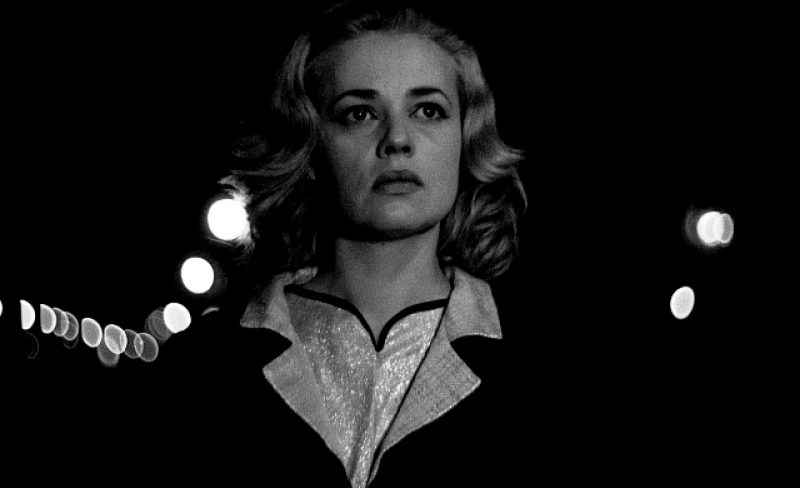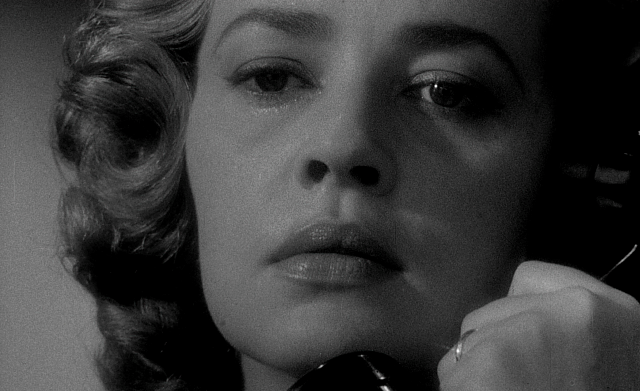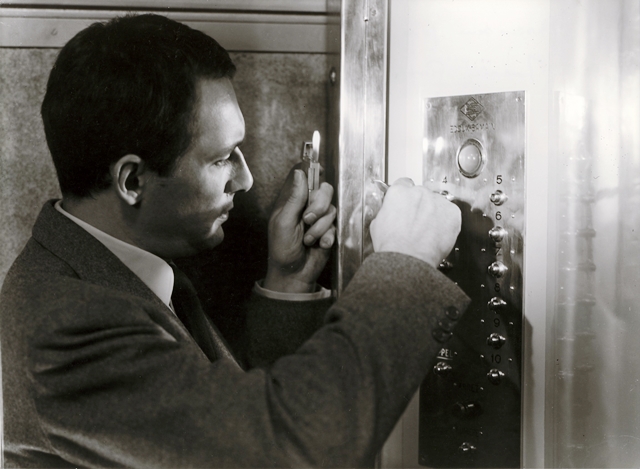Lift to the Scaffold | reviews, news & interviews
Lift to the Scaffold
Lift to the Scaffold
Atmospheric and tense Miles Davis-scored French film noir which anticipated the New Wave

A woman tramps the streets of Paris looking for a man. It’s night. It’s raining. She pops into bars asking for him. Everyone knows who he is. He’s been seen, but not recently. Earlier, early in the evening, she was supposed to meet him but he hadn’t turned up. She doesn’t know it, but he’s stuck in the lift of an office block. He thought he’d be in and out of the building in moments.
Lift to the Scaffold has three strands, linked by the actions of the woman and the trapped man. Each is woven back together as the film works towards its conclusion. It is episodic, and any one of the strands could have been enough of a basis to develop into a full-blown film. In its transition to the screen, Noël Calef's 1956 book Ascenseur pour l’échafaud did not become a standard policier.
 This isn’t a regular-issue Fifties drama, but a French take on film noir which was integral to setting the table for la nouvelle vague. Although director Louis Malle’s first fiction film, it was released after his second, Les Amants which also featured Jeanne Moreau (pictured above right).
This isn’t a regular-issue Fifties drama, but a French take on film noir which was integral to setting the table for la nouvelle vague. Although director Louis Malle’s first fiction film, it was released after his second, Les Amants which also featured Jeanne Moreau (pictured above right).
Filmed in late 1957 (a poster for American Thanksgiving day – held on 28 November 1957 – is seen in the window of a bar) and swiftly released in France in January 1958, it was first exhibited in America as Elevator to the Gallows in June 1961. Godard’s À bout de souffle (Breathless) had become an international success by then and defined New Wave for the world outside France. Malle's prototype came to America too late to claim the accolade.
The tracking shots following protagonists along streets, the real-life non-studio settings, the nods to America, the deft integration of hip music, snappy dialogue and flip, fatalistic personae Godard brought to À bout de souffle are all present to varying degrees in Lift to the Scaffold, but it isn’t quite as self-assured as what was just around the corner. It is not wholly vital and – seen now – seems a little tentative.
 However, it is incredibly striking and features a radiant Moreau as Florence Carala, the wife of a shady businessman. In the uncomfortably intimate opening moments, her face flits between fear and longing unforgettably. Maurice Ronet's Julien Tavernier (pictured above left) is set to kill in her husband in what is meant to be the perfect murder. The pair are lovers, and hope to escape after the deed. But Ronet mucks it up, is trapped in the lift leaving her adrift in the city. The young tough who steals his car is a rocker-type blouson noir and the jinks he and his girlfriend get up to encompass murder, mistaken identity and attempted suicide Lino Ventura also shines as hard-bitten cop Inspector Chérrier. In a standard French film, the part would no doubt have gone to Jean Gabin.
However, it is incredibly striking and features a radiant Moreau as Florence Carala, the wife of a shady businessman. In the uncomfortably intimate opening moments, her face flits between fear and longing unforgettably. Maurice Ronet's Julien Tavernier (pictured above left) is set to kill in her husband in what is meant to be the perfect murder. The pair are lovers, and hope to escape after the deed. But Ronet mucks it up, is trapped in the lift leaving her adrift in the city. The young tough who steals his car is a rocker-type blouson noir and the jinks he and his girlfriend get up to encompass murder, mistaken identity and attempted suicide Lino Ventura also shines as hard-bitten cop Inspector Chérrier. In a standard French film, the part would no doubt have gone to Jean Gabin.
Louis Malle had previously worked for Hitchcock and it shows
Another head-turning element is the fantastic soundtrack music, recorded by Miles Davis after Malle badgered him while he was in Paris to play dates. Improvised and recorded in one all-night session with a quartet of accompanists after Davis saw the film twice, it’s utterly sewn into the fabric of the film and has moments of sheer desolation. Davis was uncannily simpatico with something he had barely seen.
Equally diverting are political points made throughout. Ronet is ex-military and had been in Algeria and Indochina. Arms dealing and colonialism are lighted on. The rogue kids encounter an older German man who describes his country-folk as “salesmen”. So soon after the end of World War II, this must have been incredibly loaded. Malle returned to France's relations with Germany during the War more directly in 1974’s Lacombe Lucien.
Malle had previously worked briefly for Hitchcock and it shows in the tension and atmosphere, though both are erratic but hit home when piled on. The new print for this restored re-release looks stunning. Nonetheless, Moreau and Davis’s music are reason enough to see Lift to the Scaffold.
Overleaf: watch the trailer for the restored re-release of Lift to the Scaffold
Watch the trailer for the restored re-release of Lift to the Scaffold
The future of Arts Journalism
You can stop theartsdesk.com closing!
We urgently need financing to survive. Our fundraising drive has thus far raised £33,000 but we need to reach £100,000 or we will be forced to close. Please contribute here: https://gofund.me/c3f6033d
And if you can forward this information to anyone who might assist, we’d be grateful.

Subscribe to theartsdesk.com
Thank you for continuing to read our work on theartsdesk.com. For unlimited access to every article in its entirety, including our archive of more than 15,000 pieces, we're asking for £5 per month or £40 per year. We feel it's a very good deal, and hope you do too.
To take a subscription now simply click here.
And if you're looking for that extra gift for a friend or family member, why not treat them to a theartsdesk.com gift subscription?
more Film
 DVD/Blu-ray: In a Year of 13 Moons
UK disc debut for Fassbinder's neglected, tragic, tender trans tale
DVD/Blu-ray: In a Year of 13 Moons
UK disc debut for Fassbinder's neglected, tragic, tender trans tale
 The Amateur review - revenge of the nerd
Remi Malek's computer geek goes on a cerebral killing spree
The Amateur review - revenge of the nerd
Remi Malek's computer geek goes on a cerebral killing spree
 Holy Cow review - perfectly pitched coming-of-age tale in rural France
Debut feature of immense charm with an all-amateur cast
Holy Cow review - perfectly pitched coming-of-age tale in rural France
Debut feature of immense charm with an all-amateur cast
 Patrick McGilligan: Woody Allen - A Travesty of a Mockery of a Sham review - New York stories
Fair-minded Woody Allen biography covers all bases
Patrick McGilligan: Woody Allen - A Travesty of a Mockery of a Sham review - New York stories
Fair-minded Woody Allen biography covers all bases
 Blu-ray: Yojimbo / Sanjuro
A pair of Kurosawa classics, beautifully restored
Blu-ray: Yojimbo / Sanjuro
A pair of Kurosawa classics, beautifully restored
 Mr Burton review - modest film about the birth of an extraordinary talent
Harry Lawtey and Toby Jones excel as the future Richard Burton and his mentor
Mr Burton review - modest film about the birth of an extraordinary talent
Harry Lawtey and Toby Jones excel as the future Richard Burton and his mentor
 Restless review - curse of the noisy neighbours
Assured comedy-drama about an ordinary Englishwoman turned vigilante
Restless review - curse of the noisy neighbours
Assured comedy-drama about an ordinary Englishwoman turned vigilante
 Ed Atkins, Tate Britain review - hiding behind computer generated doppelgängers
Emotions too raw to explore
Ed Atkins, Tate Britain review - hiding behind computer generated doppelgängers
Emotions too raw to explore
 Four Mothers review - one gay man deals with three extra mothers
Darren Thornton's comedy has charm but is implausible
Four Mothers review - one gay man deals with three extra mothers
Darren Thornton's comedy has charm but is implausible
 Misericordia review - mushroom-gathering and murder in rural France
A deadpan comedy-thriller from the director of ‘Stranger by the Lake’
Misericordia review - mushroom-gathering and murder in rural France
A deadpan comedy-thriller from the director of ‘Stranger by the Lake’
 theartsdesk Q&A: filmmaker Joshua Oppenheimer on his apocalyptic musical 'The End'
The documentary director talks about his ominous first fiction film and why its characters break into song
theartsdesk Q&A: filmmaker Joshua Oppenheimer on his apocalyptic musical 'The End'
The documentary director talks about his ominous first fiction film and why its characters break into song
 DVD/Blu-ray: The Substance
French director Coralie Fargeat on the making of her award-winning body-horror movie
DVD/Blu-ray: The Substance
French director Coralie Fargeat on the making of her award-winning body-horror movie

Add comment